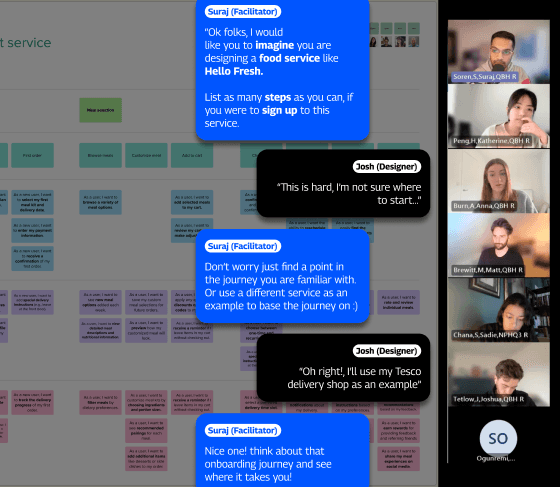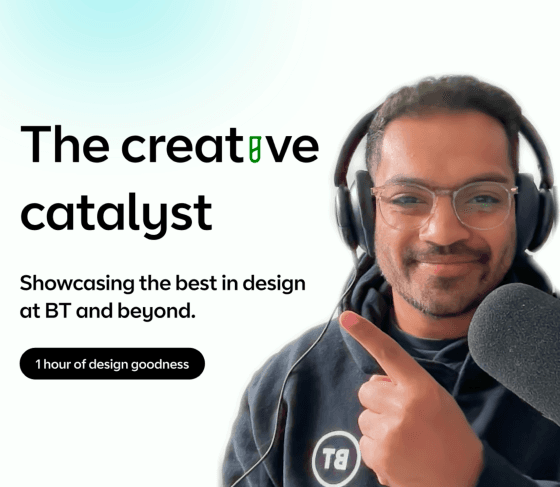10
minute read
How AI is Shaping Generational User Experiences: A Strategic Perspective for UX/UI Design
How AI is Shaping Generational User Experiences: A Strategic Perspective for UX/UI Design
Artificial Intelligence
GenAI
Strategic UX
Discover how AI is transforming user behaviour across generations and why strategic UX/UI design is essential for creating meaningful, future-ready digital experiences.

Suraj Soren
Jan 15, 2025

Constantly consuming distressing news can take a toll on our health. Learn how to safeguard your well-being. (Harvard Health Publishing, 2024)
In the fast-evolving landscape of technology, artificial intelligence (AI) is reshaping how different generations interact with digital products. For UX/UI designers, understanding these shifts is crucial to creating intuitive and impactful experiences. As businesses increasingly adopt AI-driven tools, it's more important than ever to craft designs that resonate across generational divides.
This article explores how AI is impacting Millennials, Baby Boomers, Generation X, and Generation Z, while highlighting the strategic role UX/UI designers play in this transformation.
Baby Boomers: Understanding AI
For many Baby Boomers, technology—especially AI—can feel like an invisible force working behind the scenes. Whether it's social media recommendations, voice assistants like Alexa, or online shopping, Boomers often engage with technology without fully understanding how it works or how it affects their experience. However, this presents a unique opportunity: to introduce tools that make life easier, more organized, and less stressful.
Rather than seeing Baby Boomers as "behind the curve," we can approach technology as a way to enhance their daily routines and help them stay connected. With clear, intuitive tools and gentle support, we can make it easier for them to adapt and feel confident in using technology at their own pace.
Key UX/UI Takeaway:
Make technology feel approachable by simplifying the experience and offering support from younger family members. Design tools that are intuitive and easy to understand, with clear instructions and control over settings. Encourage intergenerational learning, where younger family members can guide Boomers through new tech, helping them feel confident and reducing any anxiety around using digital tools.Generation X: Building Confidence with AI
Generation X often finds itself between analog and digital worlds, adapting to technology as it evolves. Many in this group struggle to distinguish AI-generated content from human-created materials, encountering AI-driven posts on platforms like Instagram without realizing it. This uncertainty can lead to confusion or mistrust.
For designers, the goal is to reduce this anxiety by equipping Generation X with practical tools and clear guidance. Instead of overwhelming them with technical details, design interfaces that educate users gently and provide accessible resources to stay informed about AI.
Key UX/UI Takeaway:
Highlight AI’s Role: Use subtle labels or icons to tag AI-generated content (e.g., “AI-Assisted” or “Created with AI”) so users can identify it easily.
Offer Learning Tools: Provide built-in resources or tips, like quick guides or short videos, that explain how AI works and its benefits without inducing fear.
Promote Reliable Sources: Suggest trustworthy websites or apps that help users keep up with AI trends in a digestible way, such as AI Newsletters, blogs, or tools like ChatGPT to explore AI safely.
Build Control into Design: Let users choose how much AI assistance they want (e.g., toggle options for AI recommendations), empowering them to feel in charge.
By keeping things simple and offering resources at their fingertips, Generation X can stay updated and confident without feeling overwhelmed by AI's rapid advancements.
Millennials: The AI Adopters Who Know the Risks
Millennials are uniquely positioned to navigate the rise of AI. Growing up alongside the internet, they’ve seen firsthand how technology has transformed industries. They’re quick to adopt AI tools like ChatGPT or MidJourney, using them for creative work, productivity, and even life planning.
However, Millennials also recognise the potential dangers of AI, from automation impacting jobs to ethical concerns like bias in algorithms. As UX/UI designers, addressing this generation means crafting interfaces that balance innovation with transparency, ensuring users understand the role AI plays in their experiences.
Key UX/UI Takeaway:
Focus on building trust and control into AI-driven designs, with features like explainable AI and user customisation options.
Generation Z: Digital Natives with AI-Driven Lives
As digital natives, Gen Z has grown up in a world where AI is everywhere—from TikTok’s recommendation engine to AI-based tools like Canva or Notion AI. They adapt quickly to new technologies, often using AI to enhance creativity or streamline productivity.
However, as Gen Z ages, they may face challenges similar to those of older generations, struggling to keep up with emerging tech. For designers, it’s vital to stay ahead of trends like generative user interfaces (GenUI) and tools like V0.com that are changing how websites and apps are built.
Key UX/UI Takeaway:
Design for adaptability, incorporating modular, scalable frameworks that evolve alongside users’ needs.
The Role of AI in UX/UI Design: Challenges and Opportunities
AI is not just a tool for users—it’s also transforming the field of UX/UI design itself. Tools like Webflow, Figma AI, and V0.com can automate aspects of website and app creation, enabling faster prototyping and iteration.
But while AI can streamline workflows, it’s important to remember that it’s not a replacement for creativity. Designers should use AI as a co-pilot, leveraging its capabilities to enhance their work without losing the human touch.
Staying Ahead with Generative Interfaces
One of the emerging trends in UX/UI is Generative User Interfaces (GenUI). These interfaces, powered by AI, adapt in real time to user behaviour, creating personalised and dynamic experiences. Keeping up with such trends requires constant research and experimentation.
Why Strategic UX/UI Design Matters in an AI-Driven World
For businesses looking to stand out in an increasingly AI-driven market, strategic UX/UI design is more important than ever. A thoughtful, human-centered approach ensures that AI enhances the user experience rather than detracts from it.
If you’re seeking a freelance UX/UI designer who combines creative expertise with a deep understanding of AI's impact on user behaviour, let’s collaborate to create digital experiences that resonate with all generations.
By addressing generational differences and staying on top of AI trends, we can design solutions that are not just functional but also meaningful and inclusive.
In the fast-evolving landscape of technology, artificial intelligence (AI) is reshaping how different generations interact with digital products. For UX/UI designers, understanding these shifts is crucial to creating intuitive and impactful experiences. As businesses increasingly adopt AI-driven tools, it's more important than ever to craft designs that resonate across generational divides.
This article explores how AI is impacting Millennials, Baby Boomers, Generation X, and Generation Z, while highlighting the strategic role UX/UI designers play in this transformation.
Baby Boomers: Understanding AI
For many Baby Boomers, technology—especially AI—can feel like an invisible force working behind the scenes. Whether it's social media recommendations, voice assistants like Alexa, or online shopping, Boomers often engage with technology without fully understanding how it works or how it affects their experience. However, this presents a unique opportunity: to introduce tools that make life easier, more organized, and less stressful.
Rather than seeing Baby Boomers as "behind the curve," we can approach technology as a way to enhance their daily routines and help them stay connected. With clear, intuitive tools and gentle support, we can make it easier for them to adapt and feel confident in using technology at their own pace.
Key UX/UI Takeaway:
Make technology feel approachable by simplifying the experience and offering support from younger family members. Design tools that are intuitive and easy to understand, with clear instructions and control over settings. Encourage intergenerational learning, where younger family members can guide Boomers through new tech, helping them feel confident and reducing any anxiety around using digital tools.Generation X: Building Confidence with AI
Generation X often finds itself between analog and digital worlds, adapting to technology as it evolves. Many in this group struggle to distinguish AI-generated content from human-created materials, encountering AI-driven posts on platforms like Instagram without realizing it. This uncertainty can lead to confusion or mistrust.
For designers, the goal is to reduce this anxiety by equipping Generation X with practical tools and clear guidance. Instead of overwhelming them with technical details, design interfaces that educate users gently and provide accessible resources to stay informed about AI.
Key UX/UI Takeaway:
Highlight AI’s Role: Use subtle labels or icons to tag AI-generated content (e.g., “AI-Assisted” or “Created with AI”) so users can identify it easily.
Offer Learning Tools: Provide built-in resources or tips, like quick guides or short videos, that explain how AI works and its benefits without inducing fear.
Promote Reliable Sources: Suggest trustworthy websites or apps that help users keep up with AI trends in a digestible way, such as AI Newsletters, blogs, or tools like ChatGPT to explore AI safely.
Build Control into Design: Let users choose how much AI assistance they want (e.g., toggle options for AI recommendations), empowering them to feel in charge.
By keeping things simple and offering resources at their fingertips, Generation X can stay updated and confident without feeling overwhelmed by AI's rapid advancements.
Millennials: The AI Adopters Who Know the Risks
Millennials are uniquely positioned to navigate the rise of AI. Growing up alongside the internet, they’ve seen firsthand how technology has transformed industries. They’re quick to adopt AI tools like ChatGPT or MidJourney, using them for creative work, productivity, and even life planning.
However, Millennials also recognise the potential dangers of AI, from automation impacting jobs to ethical concerns like bias in algorithms. As UX/UI designers, addressing this generation means crafting interfaces that balance innovation with transparency, ensuring users understand the role AI plays in their experiences.
Key UX/UI Takeaway:
Focus on building trust and control into AI-driven designs, with features like explainable AI and user customisation options.
Generation Z: Digital Natives with AI-Driven Lives
As digital natives, Gen Z has grown up in a world where AI is everywhere—from TikTok’s recommendation engine to AI-based tools like Canva or Notion AI. They adapt quickly to new technologies, often using AI to enhance creativity or streamline productivity.
However, as Gen Z ages, they may face challenges similar to those of older generations, struggling to keep up with emerging tech. For designers, it’s vital to stay ahead of trends like generative user interfaces (GenUI) and tools like V0.com that are changing how websites and apps are built.
Key UX/UI Takeaway:
Design for adaptability, incorporating modular, scalable frameworks that evolve alongside users’ needs.
The Role of AI in UX/UI Design: Challenges and Opportunities
AI is not just a tool for users—it’s also transforming the field of UX/UI design itself. Tools like Webflow, Figma AI, and V0.com can automate aspects of website and app creation, enabling faster prototyping and iteration.
But while AI can streamline workflows, it’s important to remember that it’s not a replacement for creativity. Designers should use AI as a co-pilot, leveraging its capabilities to enhance their work without losing the human touch.
Staying Ahead with Generative Interfaces
One of the emerging trends in UX/UI is Generative User Interfaces (GenUI). These interfaces, powered by AI, adapt in real time to user behaviour, creating personalised and dynamic experiences. Keeping up with such trends requires constant research and experimentation.
Why Strategic UX/UI Design Matters in an AI-Driven World
For businesses looking to stand out in an increasingly AI-driven market, strategic UX/UI design is more important than ever. A thoughtful, human-centered approach ensures that AI enhances the user experience rather than detracts from it.
If you’re seeking a freelance UX/UI designer who combines creative expertise with a deep understanding of AI's impact on user behaviour, let’s collaborate to create digital experiences that resonate with all generations.
By addressing generational differences and staying on top of AI trends, we can design solutions that are not just functional but also meaningful and inclusive.





